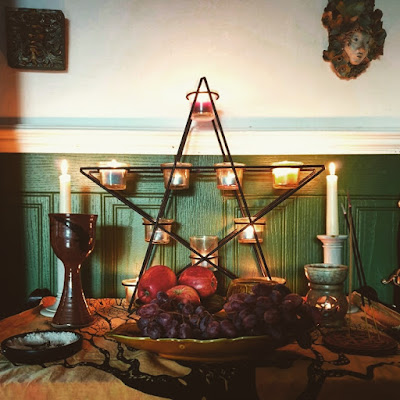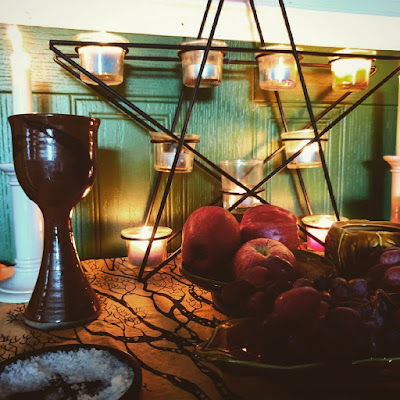No products in the cart.
Return To ShopMabon/Autumn Equinox: Our Home Altar
The Autumn Equinox is easy to explain; it is the point halfway between the longest and shortest days, when day and night are equal. Mabon is a little more complicated. Calling the Autumnal Equinox ‘Mabon’ is an innovation of Aidan Kelly; while Ostara and Lammas were part of the Anglo-Saxon calendar, and Beltane, Samhain, Imbolc and Lughnasadh were part of the Celtic calendar, and the two Solstices were parts of lots of calendars (including most famously that of the prehistoric megalithic architects), Mabon is more enigmatic. The Anglo-Saxon calendar is complicated, with lunar months orientated by solar markers, and the closest historical analog to Neo-Pagan ‘Mabon’ is what still remains as British Harvest Festival – a moveable feast on the first full moon after the Equinox (it is likely Ostara, or ‘Eostre’ was also on a full moon next to the vernal Equinox). It was not called ‘Mabon; as mentioned, that is a modern innovation naming the Equinox festival after the Welsh/Brythonic deity/mythological figure of the same name. Effectively, in a Neo-Pagan context, it is a second harvest festival – one based around fruits as Lughnasadh/Lammas is the agrarian harvest, and among other things, Samhain/Samhuinn historically involved the slaughter of livestock (for those reading about that for the first time; we don’t do animal sacrifice, and historically it was about slaughtering livestock for winter meat).
 Raven’s jian sword in the corner, and the right side of our altar
Raven’s jian sword in the corner, and the right side of our altarThe altar-cloth is orange tie-die, with a leafless tree on it -I think this is a suitable autumnal scene. Unusually, I did not layer my altar-cloths, but this was simply out of forgetting; I had intended to use a purple scarf under it, but I just didn’t remember until I had started putting all the rest of the items on it, and did not want to take them off. Perhaps a touch lazy…
 Our Mabon altar, front view.
Our Mabon altar, front view.
I have discussed the pentagram candle-holder in my previous blogs on the Wheel of the Year. The incense burner is a pentacle, but it only has three out of five possible incense sticks. My athame with the leaf-shape blade is a brass letter opener salvaged from a building that was to be demolished. The wand is oak, and was carved for me by a friend. The oil burner has a pentacle on it too – I love how it glows amber through the stone itself when it is lit. I felt the round shape and warm colours were reminiscent of a fruit, which is why I selected this specific oil-burner. The offerings are self-evident, each in a dish purchased from a charity shop. The round plate is hand-made. I’m missing the lid for the cabbage-shaped jar (which ended up with nuts in it).
 Chalice and fruit in front of pentagram candleholder
Chalice and fruit in front of pentagram candleholder
I really enjoy the replacement chalice; it feels very earthy – technically all ceramics are earthy in that they are made of clay, but being earthenware, glazed brown, and chunky makes this feel very organic and natural. It really makes me happy to find all this nature-themed crockery in my local charity shops. The grapes are in a dish shaped like an autumn leaf, too! The chalice concept is from Wicca, where chalices are used for the symbolic Great Rite, where a phallic athame and round receptacle symbolise the genitive process, and for the ‘cakes and ale’ (shared consumption of food and drink as community bonding) – however, I am not Wiccan, and don’t adhere to the fertility model that emphasises sexual reproduction as metaphorical for natural fecundity; nature’s mating habits are far too peculiar – from parthenogenesis in stick insects to pregnant male sea-horses, to entire forests where trailing mycelium connects every patch of honey-fungus, nature is rather broader than the habits of mammals. Communal eating from the same plate is one thing, but for group rituals there’s a common pitcher and separate glasses for hygiene reasons. My chalice is for eating and drinking as part of the grounding process after completing the main body of ritual, a way to maintain a mindset in the material after meditation, trance and the like. A chunky goblet is useful for not being easily broken by my dyspraxic self. Apples and grapes to consume as part of the ritual, and also give as offerings to the birds
Apples and grapes to consume as part of the ritual, and also give as offerings to the birds
 Apples and grapes to consume as part of the ritual, and also give as offerings to the birds
Apples and grapes to consume as part of the ritual, and also give as offerings to the birdsFruit was store-bought; my back garden is a work in progress and doesn’t produce fruits, plus I am likely too far north for grapes. Crab apples grow locally, and my garden is more sheltered than my father’s small holding on a Welsh hillside that produces a good crop of apples, but our last attempt at an apple tree ended with a sapling that did not survive winter.I hope you have found this blog article informative. I intend to post in depth about Samhain/Samhuinn and Yule too.

